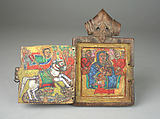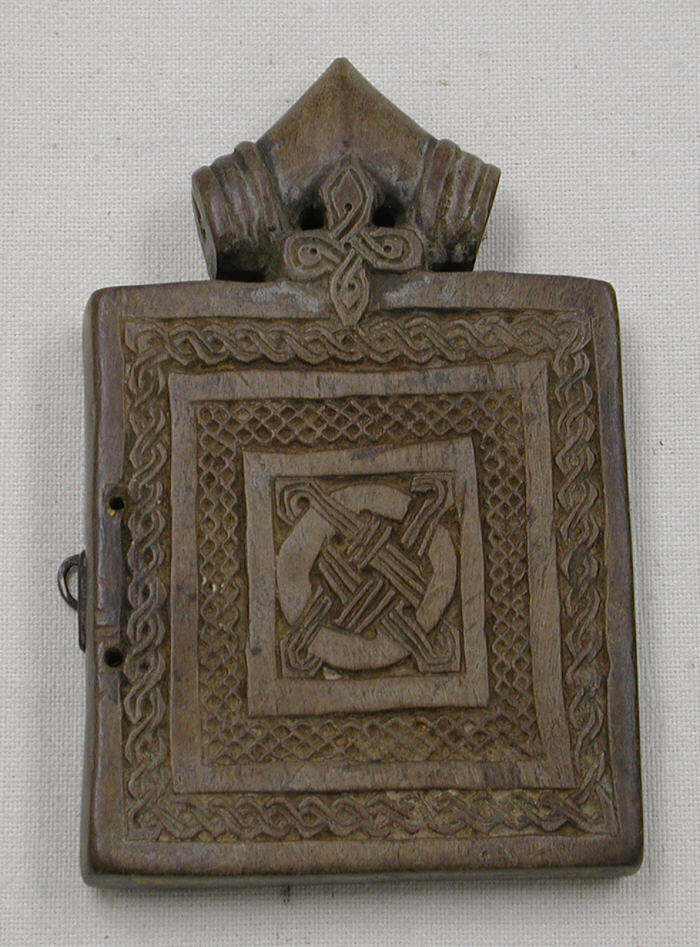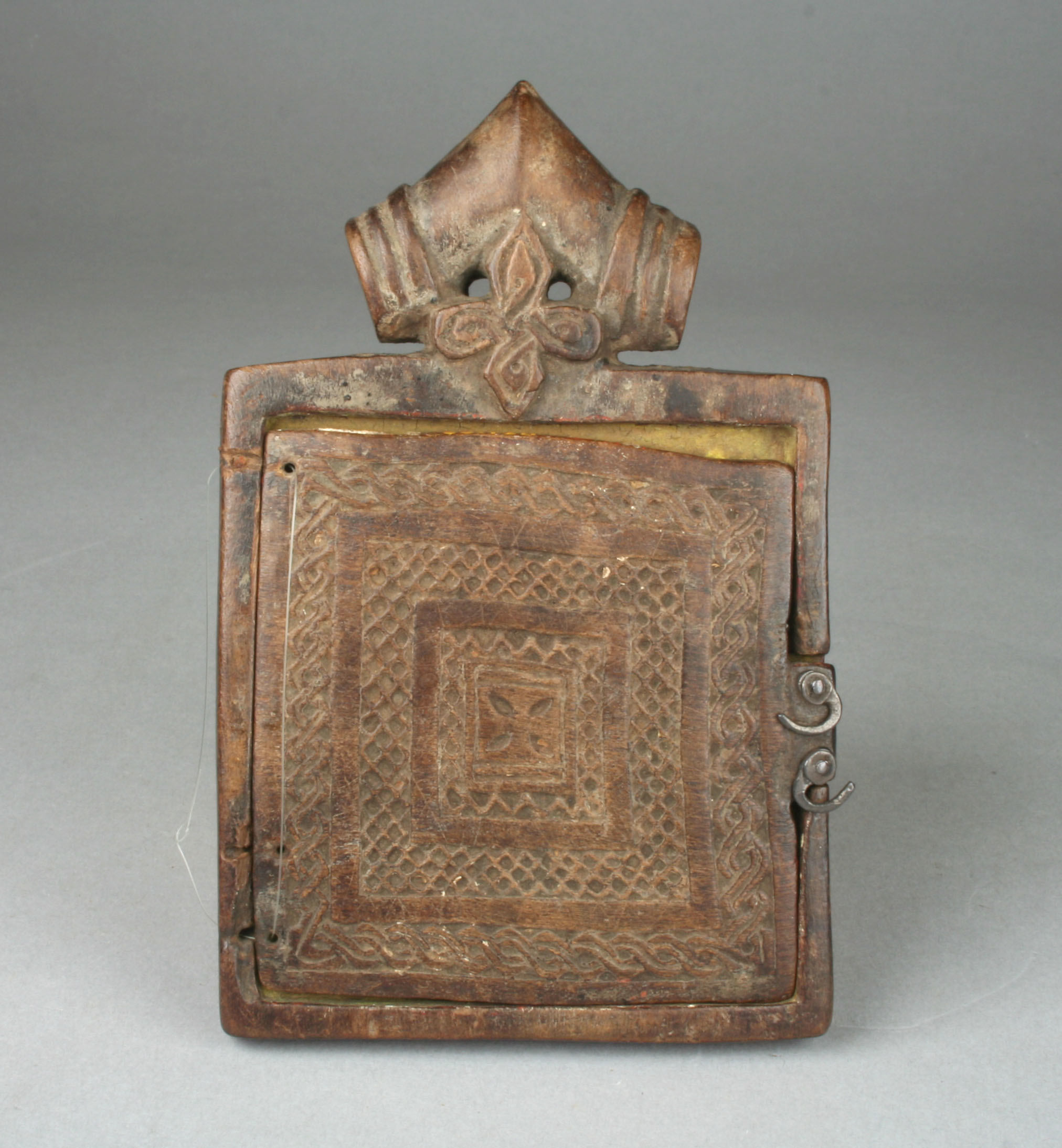Pendant Icon: St. George, Virgin and Child Enthroned
Not on view
This pendant’s intimate scale and protective external panel allowed it to be used as a portable personal icon. The single-faced diptych’s carved wooden case could be opened to reveal paintings of the Virgin Mary and St. George, two of the most popular figures in Ethiopian Orthodoxy Christianity. The hollow inverted v-shaped cylinder at the top enabled it to be suspended from the owner's neck. An interlaced square cross is carved below the loop on each side. Two small c-shaped hooks are mounted on hinges on the right side of the front of the case. They likely fit into a now-missing latch, which would have been attached to two holes pierced through the reverse of the case. Both the front and back of the case are ornamented with shallow carved designs alternating with plain bands. The front of the case has four plain bands, and three patterned with interlace, hatching, and zigzags. A flared pattée cross is at its center. On the reverse of the case are three plain bands interspersed with two bands carved with interlace and hatching. They frame an inner cross composed of a diagonal three-band interlace enclosing a circle. The wood on the front and sides of the case have a slight sheen, and is darker than that of the back.
On the principle side, the main panel features Mary and the Christ Child flanked by two archangels. She carries the Christ child on her right side, and holds a mappula (handkerchief) in her left hand. Her sweeping blue robe, edged with yellow and green, covers her hair. A small yellow halo surrounds each figure’s head. This form of the Virgin and Child was modeled after the Virgin of Santa Maria Maggiore, first introduced into Ethiopia in print form by the Jesuits around 1600. Rather than slavishly copying the European model, the Ethiopian artists adapted it to their own aesthetic preferences, as evident by the short, cropped black hair of Christ and the archangels. Instead of standing against a blank backdrop, as the Virgin does in the European model, the Virgin sits on a throne draped with bright yellow cloth enlivened with a red grid pattern. The addition of the throne, as well as the winged archangels—who each hold a hand cross particular to Ethiopian priests-- is itself drawn from Ethiopian models of the Virgin dating to the fourteenth century or earlier. The child’s striped robe, reminiscent of locally-produced woven textiles, and bare feet also represent a departure from the print. Believed to be an intercessor between humans and God, the Virgin Mary is one of the Ethiopian Orthodox church’s most venerated figures. Mary’s personal presence is felt through her divine images, thus making this a diminutive, yet powerful object.
St. George slaying the dragon is represented on the adjacent panel. Like many Ethiopian saints, he is depicted on horseback; the distinctive white coat of his horse helps to identify him. The horse’s trappings are simple strips of red and green, ornamented only with yellow rings on the harness. Like the male figures in the adjoining panel, St. George has a halo and close-cropped black hair. His robe of green, blue, and red flies out behind his right arm, which he raises to point a long spear at a scale-covered dragon. The painting has captured the moment when the tip of the spear enters the dragon’s open mouth. Recoiling beneath the feet of the white steed, the dragon has a curling tail and a single eye, a hallmark in Ethiopian Orthodox painting of evil figures. Images of St. George the Dragon-Killer represent the triumph of good over evil, in which the warrior saint is a knight of Christ. To the saint’s right is Birutawit the Maiden, dressed in a long red robe. She is perched in a tree whose leaves are represented by irregular circles of green sprouting from slender brown branches. Iconography of the rescued maiden arose in Ethiopian icons of St. George in the fifteenth century. His pose, dress, and equipment evoke imagery of noble Ethiopian warriors, placing the story of the powerful saint in Ethiopia itself. Given the damage to the paint, it is difficult to determine the original state of the background, though it appears to have been a solid yellow field.
Images of St. Mary and St. George were frequently juxtaposed in diptychs and other icon paintings because they were linked in the Senkessar, a religious text with the death dates of the saints and short commentaries on their lives. In the Senkessar, the Feast of the Assumption of both the Virgin and St. George take place on the same day (16 Nähase). As is typical in these pairings, St. George rides towards the Virgin in this diptych, emphasizing his role as Christian protector.
Pendant icons became popular in the seventeenth century, and remained common until the nineteenth. The dating of this work is contested: it has been suggested that given the execution of the painting and its bright pigments, it is highly likely that a carved case of an earlier date and higher quality was repainted sometime in the twentieth century, using the historic Gondärine style. The Gondärine style evolved in the courtly scriptoria in the mid-seventeenth century, and remains a popular model for present-day painters of religious art. It is generally characterized by the use of three-quarter pose, vivid pigments, the inclusion of both secular and religious objects, and the detailed rendering of textiles. While the "First Gondärine" style tended towards flatter depictions, the "Second Gondärine" incorporated more naturalistic shading. The left-most painting is webbed with cracks, revealing the thin layer of gesso applied to the wood before painting. The handling of the paint suggests an inexpert artist who was unable to achieve the opaque surfaces common in the finest Ethiopian paintings. It also lacks a solid definition of lines or the precise modeling of figures, shading, or textiles characteristic of the Second Gondärine style, of which is attempts to imitate. The bright palette—neon yellow, Kelly green, black, red, pink, electric green, and blue—suggests the use of commercial paints, rather than locally-made ones, which would have been made from mineral and organic pigments. Despite the shortcomings of its execution, the images of Mary and St. George testifies to the longevity of the influence of the Gondärine style on Ethiopian Orthodox art. Additionally, the work has a noteworthy provenance, as it was gifted by Princess Hirut Desta (Ruth), granddaughter of the Emperor Haile Selassie, to Lila Wallace, co-founder of the American magazine Reader’s Digest.
Kristen Windmuller-Luna, 2016
Sylvan C. Coleman and Pam Coleman Memorial Fund Fellow in the Department of the Arts of Africa, Oceania, and the Americas
Further Reading
Chojnacki, Stanislaw. "The Iconography of St. George in Ethiopia Pts. 1 & 2." Journal of Ethiopian Studies 11, no. 1 & 2 (1973): 57-73, 51-92.
Chojnacki, Stanisław, and Carolyn Gossage. Ethiopian Icons: Catalogue of the Collection of the Institute of Ethiopian Studies Addis Ababa University. Milan: Skira, 2000.
Heldman, Marilyn Eiseman., S. C. Munro-Hay, and Roderick Grierson. African Zion: The Sacred Art of Ethiopia. New Haven: Yale University Press, 1993.
Exhibition History
Art of Ethiopia, Katonah Gallery (Katonah, New York), November 3–December 17, 1968
Due to rights restrictions, this image cannot be enlarged, viewed at full screen, or downloaded.
This artwork is meant to be viewed from right to left. Scroll left to view more.




